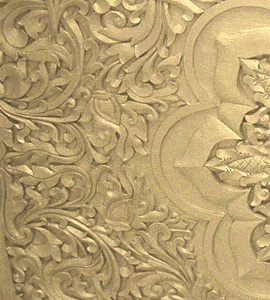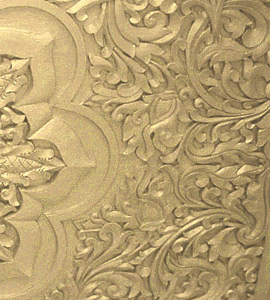


My Teacher, My Benefactor!
Sayagyi U Ba Khin (1899-1971), was one of the most renowned Vipassana teachers of his time. U Ba Khin was the first Accountant General of independent Burma, and simultaneously held three other very high offices in the government of Prime Minister U Nu. While serving as Accountant General, he started the Vipassana Research Association in his office. In 1952, U Ba Khin founded the International Meditation Centre (IMC) on 1.5 acres of land at 31a Inya Myaing Road, University Post Office, Rangoon (Yangon), in the old British neighborhood four miles from the famous Shwe Dagon Pagoda. For the next 29 years, IMC was to be the fulcrum of his life, despite his numerous responsibilities as a senior government officer.
On January 19, 1971, the day Sayagyi U Ba Khin passed away, Goenkaji was conducting a 10-day course at the Burmese Vihara in Bodh Gaya. When news of his teacher’s death reached him (it was the second day of the 10-day course), Goenkaji sent a telegram back to IMC, which contained the momentous words of the Buddha:
Anicca vata sankhara,
uppadavaya-dhammino.
Uppajjitva nirujjhanti,
tesam vupasamo sukho.
Impermanent truly are compounded things,
by nature arising and passing away.
If they arise and are extinguished,
their eradication brings happiness.
(Mahaparinibbana-sutta, Digha-nikaya 2.3, 221)
A copy of this telegram was distributed at Sayagyi U Ba Khin’s funeral.
Over a year after his beloved teacher passed away, Goenkaji had written this article in April 1972, for the Sayagyi U Ba Khin Centenary issue published by the Maha Bodhi Society, and has been adapted.
While I was travelling around the world desperately searching for a cure for my severe migraine headaches, my good friend U Chan Htoon (who later became a judge of the Supreme Court of Burma and President of the World Fellowship of Buddhists) guided me to Sayagyi U Ba Khin. I shall always remain grateful to U Chan Htoon and continue sharing with him all merits gained on this Noble Path.
My first meeting with Sayagyi U Ba Khin was wonderful. The atmosphere around him was charged with peace and compassion. I straightaway promised him to soon attend one of his ten-day intensive Vipassana meditation courses. But I hesitated for the next six months, partly because of being skeptical that a meditation technique could cure what the best medical expertise in the world could not, and partly because of fears of being converted to Buddhism.
Coming from a very orthodox Hindu family, I wrongly thought that Buddhism was a path of renunciation that was not much use for worldly people. The second misgiving was my deep attachment to Swadharma (one’s own religion) and strong aversion to Paradharma (other religions) without realizing what Swadharma and Paradharma are.
Yet, there was something within pulling me towards this great saint Sayagyi U Ba Khin, towards the island of peace the Vipassana Centre at Inya Myaing, and towards this Noble Path with which I must have been acquainted in earlier lives, though I was unaware of this then.
So, after the Burmese monsoon was over and meditation courses resumed at the centre, I enrolled for ten days. These ten days were the most illuminating days of my life. The migraine was a blessing in disguise. A new Goenka was born, breaking free from the dark shell of ignorance of how one harms oneself.
This was the big turning point. Now I was on the path of Dhamma, on the path of real happiness and liberation from all miseries, on the straight path. It has no blind alleys from which one has to turn back.
All doubts and misgivings vanished. The physical pain of migraine was small compared to the far greater suffering within caused by negativities of the mind, negativities that one is not aware of due to ignorance of the reality within. I had not realized how much I was the cause of my own suffering.
The objective self-observation path of Vipassana revealed how I was a tangle of knots, Gordian knots of tensions, anger, intrigues, malice, hatred, jealousy, ill-will. Now I realized what the deep-rooted real causes of my suffering were, realized the remedy that could totally eradicate these causes, and thereby realized how I could benefit from the total eradication of suffering.
Walking on this Dhamma path, using this mind detergent of Vipassana, I started enjoying the beneficial results, here and now. The Sanditthiko and Akaliko qualities of Dhamma started manifesting themselves and they fascinated me, for like my teacher, I too liked being practical and liked giving all importance to the present.
Now I understood how Vipassana is not only for monks and nuns. Millions upon millions of householders in the past and present have benefited from this Eightfold Noble Path. I also realized how much Vipassana is non-sectarian, universal, and beneficial for all beings.
Now I fully realized that the real Swadharma is getting established in Sila (morality), Samadhi (mastery of the mind), and Panna (wisdom from direct experience); the real Paradharma was liberating oneself from lobha (craving), dosa (aversion), and moha (ignorance).
In the next few years, there were big changes for the better in my life, in my outlook, in dealing with different situations. I realized that Vipassana is no ostrich-like escapism. We face the hard realities of life and Vipassana gives us the necessary strength to face problems with peace and equanimity of mind. It gives us an art of living, living harmoniously within and with others.
With Vipassana practice, the mind gradually becomes purer, and with more purity, the mind becomes calmer, clearer, steadier, and penetratingly wiser.
In my business life, my capacity to work efficiently tremendously increased. Sayagyi U Ba Khin was himself a brilliant example. His efficiency and integrity were exemplary. They were the reason why he was asked to continue serving successive governments for twelve years, after the age of retirement of 55.
Sayagyi’s life inspired his students, including myself. He held very important governmental posts, at one time heading four departments. In such a powerful position, he could have easily amassed millions secretly in foreign banks. But that was not the way of Dhamma Vihari U Ba Khin. He felt fully satisfied to have left only a small cottage-type house for his son and daughters as the only saving of his honest earnings.
Neither offer of bribes from dishonest traders, nor threats from political bosses could stop him from taking right decisions. On many occasions, he also displeased business magnates, his civil service colleagues and cabinet ministers because he would not compromise on anything he found illegal and immoral.
Besides being an ideal government administrator, he was an ideal Vipassana teacher. He conducted courses with immeasurable love and compassion for students, inspite of his steel-like strictness for discipline – which actually reflected his true compassion. He did not like to see anyone wasting time, when one could benefit so much.
At the International Meditation Center (IMC), he gave equal compassionate attention to the ex-president of the country and a peon, to the judge of the Supreme Court and a criminal.
Such was U Ba Khin, a jewel among men. Such was my noble teacher who taught me the art of a sane life. Such was my benefactor who made me reap the rich harvest of Dhamma-Ratana which has proved much more valuable to me than all the material wealth that I had accumulated in my business life.
It was my great punna-parami indeed that I was born and brought up in Burma, the land of living Dhamma; that I came in contact with Sayagyi U Ba Khin, the saintly teacher of the Noble Path. May the light of Dhamma shine over the world.
May all beings be happy!
- S. N. Goenka

